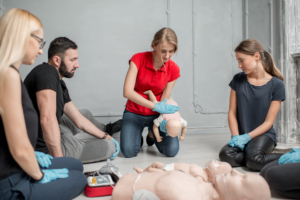Child First Aid & CPR: Essential Knowledge for Caregivers
Ensuring the safety and well-being of children is a top priority for parents, caregivers, and educators. The Canadian Red Cross Comprehensive Guide for First Aid and CPR provides detailed instructions on how to handle emergencies involving children. Here’s a breakdown of the essential knowledge and skills you need to effectively respond to such emergencies.
Recognizing and Responding to Emergencies
In any emergency, quickly and calmly assess the situation. Ensure the scene is safe for both you and the child. If the child is unresponsive or not breathing, immediate action is necessary. Call emergency services right away, providing clear information about the child’s condition and your location.
- Check for Responsiveness: Gently tap the child and shout to see if they respond.
- Positioning: Place the child on a firm, flat surface.
- Chest Compressions: Use one or two hands (depending on the child’s size) to perform chest compressions in the center of the chest, about 2 inches deep at a rate of 100-120 compressions per minute.
- Rescue Breaths: After every 30 compressions, give 2 rescue breaths. Tilt the child’s head back slightly, pinch their nose, and cover their mouth with yours, giving a gentle breath until you see the chest rise.
- Continue CPR: Continue until the child shows signs of life, such as moving or breathing, or until emergency medical help arrives.
- Assess the Situation: If the child can’t cry, cough, or breathe, they may be choking.

- Back Blows: Stand or kneel behind the child, and give up to 5 firm back blows between the shoulder blades.
- Abdominal Thrusts: If back blows are not effective, stand behind the child and give up to 5 abdominal thrusts (Heimlich maneuver).
- Alternate Between Back Blows and Abdominal Thrusts: Continue until the object is dislodged or the child becomes unresponsive. If the child becomes unresponsive, start CPR and call for emergency help.
Additional Child First Aid Skills
- Managing Wounds:
- Minor Cuts and Scrapes: Clean the area with water, apply an antibiotic ointment, and cover with a sterile bandage.
- Severe Bleeding: Apply firm pressure with a clean cloth or bandage to control bleeding and seek medical help immediately.
- Treating Burns:
- Minor Burns: Cool the burn under running water for at least 10 minutes and cover with a sterile, non-stick dressing.
- Severe Burns: Do not remove any clothing stuck to the burn. Cover the burn with a clean cloth and seek emergency medical assistance.
- Recognizing and Responding to Common Illnesses:
- Fevers: Monitor the child’s temperature. If the fever is high or the child appears very unwell, seek medical advice.
- Seizures: Protect the child from injury during a seizure by removing nearby objects. Do not restrain the child. Seek medical help if it’s their first seizure or it lasts longer than five minutes.
- Poisoning:
- Identify the Poison: Try to determine what the child has ingested.
- Do Not Induce Vomiting: Unless advised by a poison control center or medical professional.
- Call Poison Control: Seek immediate advice and follow their instructions.
Preventative Measures
Preventing accidents and emergencies is always better than having to respond to them. Ensure the environment is safe by removing hazards, securing furniture, and keeping small objects out of reach. Educate yourself on first aid practices and keep a well-stocked first aid kit accessible.
Conclusion
Knowing how to perform first aid and CPR for children can save lives and prevent complications. By staying informed and prepared, you can provide crucial support in emergencies. For more detailed information, refer to the Canadian Red Cross Comprehensive Guide for First Aid and CPR.
For caregivers looking to get certified in child first aid and CPR, consider enrolling in a course with Alert First Aid. Ready to get certified? Register for a Child First Aid and CPR course today to ensure the safety of the children in your care.



